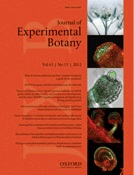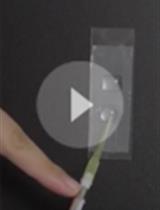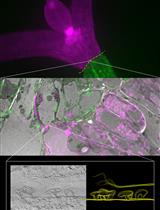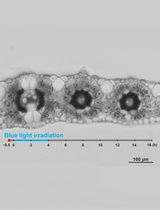- EN - English
- CN - 中文
Measuring Stomatal Density in Rice
水稻叶片气孔密度的测定
发布: 2013年05月05日第3卷第9期 DOI: 10.21769/BioProtoc.753 浏览次数: 20288
评审: Ru Zhang
Abstract
The number of stomata on leaves is known to be affected by various environmental factors and intrinsic developmental program. Stomatal density and stomatal index are generally used as indicators of the leaf development and the plant growth. This protocol describes an easy, non-destructive method for preparing imprints of the rice leaf surface that is suitable for observation and counting of stomata. Researchers can process many leaf samples at once in the field or in the green house distance from the laboratory.
Keywords: Rice (水稻)Materials and Reagents
- Microscope cover glasses (Matsunami Glass, 24 x 40 mm No.1)
Note: Though tougher glass slides (1-1.2 mm thickness) are safer, you should use cover glasses if the objective lens of the microscope is designed for standard 0.17 mm glass thickness. Only special objective lenses that have long working distances (ELWD, LWD) will allow observation through a thick glass slide. Alternatively objectives designed for use without a cover glass (NCG, NC) will enable direct observation of imprints placed on the slide glasses. I use large (24 x 40 mm) glasses for making imprints covering large leaf area. Larger glass is also useful when you set it on the microscope stage. - Instant glue (Aron Alpha Super Set) (Toagosei Co., catalog number: EA936A-5 )
Note: Aron Alpha Super Set includes liquid glue and accelerator. Aron Alpha is sold as Krazy Glue in North America and Cyanolit in Europe. - Accelerator for instant glue
Note: While I use the genuine accelerator made by Toagosei, third-party accelerators developed for Aron Alpha (Krazy Glue) will work fine. You can observe stomata without the accelerator, but the imprints may be less clear.
Equipment
- Light microscope with equipment for photomicrography
- Eyepiece micrometer and stage micrometer
Note: These are indispensable for measurement of field of view unless your microscope can automatically calculate scale bars.
Procedure
文章信息
版权信息
© 2013 The Authors; exclusive licensee Bio-protocol LLC.
如何引用
Kusumi, K. (2013). Measuring Stomatal Density in Rice. Bio-protocol 3(9): e753. DOI: 10.21769/BioProtoc.753.
分类
植物科学 > 植物生理学 > 组织分析
植物科学 > 植物细胞生物学 > 细胞结构
细胞生物学 > 组织分析 > 组织分离
您对这篇实验方法有问题吗?
在此处发布您的问题,我们将邀请本文作者来回答。同时,我们会将您的问题发布到Bio-protocol Exchange,以便寻求社区成员的帮助。
Share
Bluesky
X
Copy link













